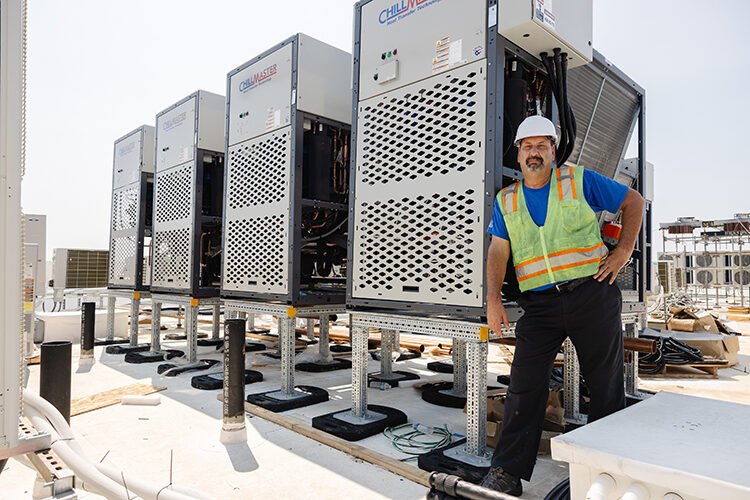Back on My Boiler Box
Hybrid systems of all kinds are gaining popularity and boilers, the unsung heroes of the heating world, are ideal for these applications.

According to Market Research 365, the residential boiler market is poised to reach $164 billion by 2035, up from its current value of $60 billion. And that’s only the residential market.
Boilers are awesome, aren’t they? The boiler — or the earliest iteration of the appliance we know and love — was invented in the early 18th century. A Scotsman by the name of James Watt is most often credited with building the first boiler (steam, of course), though Watt significantly improved an earlier design, which was used as a steam engine since the 1760s.
Today, we use steam and water boilers for countless purposes. They can efficiently heat floors, ceilings, walls and forced air for space heating alone. They can generate domestic hot water, heat pools and melt snow. They’re even used to warm golf courses to keep turf in playing condition year-round.
They sterilize equipment in hospitals and are used almost endlessly in food processing. They also play a massive role in manufacturing. Ironically, the production of electric vehicle batteries relies on boilers.
Boilers can be fired by gas, oil, propane, electric, wood and other biomass fuels. We may even see hydrogen boilers in mass production not too long from now.
They are the unsung heroes of the heating world. We’re witnessing a boiler resurgence because they’re universal, efficient and comfortable.
The Future is Hybrid
Another reason I’m bullish on boilers is because the whole world is going hybrid. Hybrid systems of all kinds are gaining popularity. That’s because hybrid systems offer the best that two (or more) technologies can offer. Boilers are the most adaptable heat source known to man (or at least to me).
You can do almost anything with a boiler; in the case of condensing boilers, they’re also extremely responsive. This makes them ideal for a wide variety of hybrid heating systems. Let me give you an example.
I’m in the midst of building a hybrid pool heating system in downtown Philadelphia. When finished, this facility will include four outdoor pools and a spa, totaling 191,000 gallons. The spa will remain at 102 degrees year-round, while the pools will be maintained at 85 degrees in the summer and 45 degrees in the winter.
To do this, they’re installing four ChillMaster air-to-water heat pumps. Each unit can generate 360,000 BTU/hour at full capacity. However, there’s a catch: as the outdoor temperature drops, so does the coefficient of performance (aka efficiency) and the total capacity of the heat pump. I’m not opposed to the use of heat pumps at all. I am, however, opposed to people believing that heat pumps can be used to replace all other sources of heat.
Due to their extraordinary cost, these heat pumps aren’t sized for the full heating load of the pools. Combined, they provide 1.8 million BTU/hour at full capacity. They’re sufficient to satisfy the load during the summer and part of the shoulder seasons. The rest of the time, the facility will rely on the boiler system we’re installing in tandem with the heat pumps.
The boiler plant includes two Thermal Solutions AMP boilers, each 1.5 million BTU/hour in capacity. Condensing boilers can satisfy the entire heat load of the pools year-round. It’s worth mentioning that the material cost for the 1.8 million BTU/hour heat pumps is four times more than the cost of the 3 million BTU/hour boilers, not including the electrical service upgrade needed at the site for the giant heat pumps.
Residential Hybrid
You might think, “Sure, a hybrid boiler system works in a commercial application, but it’s not effective on a residential job.”
Respectfully, I beg to differ. My own home has a hybrid system. It’s an older house; nothing fancy, but it is super-insulated with closed-cell spray foam, giving me a heat loss of 13 BTU/hour per square foot at a 12-degree outdoor design temperature. Otherwise, it’s a very average house, with a 12-year-old unitary heat pump and single-zone ductwork throughout.
My heat pump provides air conditioning and heat during the shoulder seasons. When it gets cold outside, a hydronic coil in the ductwork takes over, thanks to heat from a 180,000-BTU/hour condensing boiler.
After recording my energy expenses for several years, I’ve found that the optimal outdoor ambient switchover temperature (the point at which the efficiency of the boiler exceeds that of the heat pump) is 44 degrees.
Of course, the efficiency of the heat pump and the boiler (along with regional power and fuel prices) will slide the switchover temperature one way or the other on a case-by-case basis. I suspect that if I upgraded to a new heat pump, I could run it efficiently for most of the shoulder season and even into mild winter days.
My boiler serves a few other purposes, too. It produces all my domestic hot water, there’s a small zone of snowmelt, and I heat my garage with a hydronic fan coil.
No Heat Pump Hate
If you’ve read this column for a while, you know that I don’t hate heat pumps. I think they’ll play a vital role in the sustainability of our industry. I am, however, critical of the electrification movement because we need to further develop our energy sources and electrical infrastructure in this country before jumping headlong into the heat pump bandwagon.
In my opinion, the market needs to drive this development, not the government. If the customer sees the value in an alternative technology and the return on investment supports it, the consumer will invest in it.
In fact, the heat pump industry is poised to make a giant leap forward in the United States over the next few years. A2L refrigerants, already in use across the globe for a decade, will finally be used in the heat pumps available to U.S. customers. This is extremely important because heat pumps will be more environmentally friendly than ever before.
Take R-32, for example, one of the leading A2L options. R-410a has a global warming potential (GWP) of 2088. R-32, in comparison, has a GWP of 655, a 70 percent reduction in GWP.
Make no mistake, heat pumps are a fantastic technology and getting better by the day. However, the simple fact remains that the current electrical infrastructure in this country can’t accommodate the adoption of heat pumps at the rate the government would like to see full electrification implemented. Not yet, anyway, and not for decades to come, if we’re being honest with ourselves.
That takes us back to boilers. The solution isn’t heat pumps instead of boilers. The solution is heat pumps and boilers. The numbers projected by Market Research 365 support my hypothesis.





